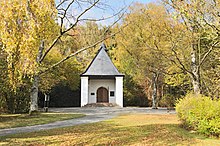Forced recruits from Luxembourg

As Luxembourg forcibly recruited (Luxem. Zwangsrekrutéierten ) are Luxembourg men referred that during the Second World War in the German Wehrmacht had to perform against their will service. The corresponding expression for the approximately 130,000 forcibly conscripted Alsace - Lorraine soldiers is called Malgré-nous in French .
Second World War
Forced recruits (French enrôlé de force ) are (mostly) young people who are forced to serve in a foreign army. The conscription in annexed Luxembourg was on 30 August 1942 Gauleiter Gustav Simon announced. At the beginning, this regulation only affected those born between 1920 and 1924; later conscription was extended to those born between 1925 and 1927. The German government at the time actually violated its own Defense Act of May 21, 1935, which stipulated membership in the Reich as a requirement for compulsory military service. The decree led to a nationwide general strike , which was crushed. Luxembourgers who wanted to evade forced recruitment or who took part in the strike were deported to the Hinzert concentration camp near Trier .
A refuge for Luxembourg men was the Hondsbësch gallery , a disused part of the mine near Niederkorn , in which up to 122 refugees were hiding at times.
Similar regulations on compulsory military service issued by the German civil administration led to the fact that the male Alsatians , Lorrainers from the CdZ area of Lorraine , and the German-speaking Belgian soldiers from the so-called eastern cantons were drafted. The fact that the conscripts had to fight their own allies was particularly bad for those affected.
Between 1943 and 1945, 1900 forced recruits from Luxembourg were made prisoners of war by the Soviets, around 1000 of whom were sent to the Tambov POW camp . 165 did not survive the conditions there and are in the neighboring Rada cemetery. 38 died in the Kirsanov hospital and 50 more died on the way back home.
On January 30, 1945, shortly before the liberation by the Red Army , 91 Luxembourgers (mostly forced recruits) were murdered in an end- stage crime in the Sonnenburg prison .
post war period

In 1960 the Western European forced recruits from Alsace, Lorraine, Luxembourg and Belgium founded the “International Federation of Forced Recruits, Victims of Nazism” based in Luxembourg and in 1965 published the memorandum “La Grande Honte” (The Great Shame) to pressure for compensation from Germany . In 1972 the Foreign Office recognized the forced integration into the Wehrmacht as an elementary violation of human rights, but considered that compensation payments were only possible after a peace treaty had been signed. In the 1980s the German federal government paid 250 million DM as symbolic compensation into a fund, ie a little more than 3000 DM per person to the approximately 80,000 survivors affected.
In 2012, a memorial was inaugurated in the "Peter and Paul" cemetery in Tambov for the Luxembourgers who were forcibly recruited from the Tambov prison camp.
In 1996, the Mémorial de la Déportation was set up as a memorial in the former Hollerich train station , from which the forced recruits left. It commemorates the deportation of Jews, forced recruits and resistance workers.
See also
- Malgré-nous
- Relocation for Luxembourg
- Hinzert concentration camp
- The general strike of 1942 in Wiltz
literature
- Peter M. Quadflieg : "Forced Soldiers" and "Ons Jongen". Eupen-Malmedy and Luxembourg as recruiting areas for the German Wehrmacht in World War II. Aachen 2008, ISBN 978-3-8322-7078-0 .
- André Hohengarten: The forced recruitment of Luxembourgers into the Wehrmacht and the SS special camp / Hinzert concentration camp , pdf, Hinzert 2006
- Norbert Haase: From “Ons Jongen”, “Malgré-nous” and others - The fate of foreign forced recruits in World War II , PDF, lecture at the University of Strasbourg, August 27, 2011
- Henri Leyder: The big end came after , PDF, Gemeng Ell history association on the history of the forcibly recruited Leo Graf, Luxembourg
Web links
- Hollerich station museum in memory of Benelux
Individual evidence
- ^ André Hohengarten: The forced recruitment of Luxembourgers to the Wehrmacht and the SS special camp / Hinzert concentration camp , pdf, Hinzert 2006
- ↑ Directive iwwer d'Rechtslage der Luxemburger, déi known at the Hirschberg camp on April 5, 1943 gouf = directive on the legal situation of Luxembourg, announced at the Hirschberg camp on April 5, 1943
- ↑ Return from the Tambow prison camp , Luxemburger Wort, published November 5, 2015, accessed on August 4, 2016.
- ↑ Sonnenburg massacre - mass murder still deep in memory after 70 years , Luxemburger Wort, January 30, 2015, accessed on October 27, 2015.
- ↑ Manfred Kittel: German-speaking minorities 1945: a European comparison , Oldenbourg Verlag, 2007, ISBN 3-486-58002-7 , p. 451 ff.
- ↑ Gegen das Vergessen , Tageblatt, published September 26, 2012, accessed on August 4, 2016.
- ^ Museum Bahnhof Hollerich , memorial site portal on places of remembrance in Europe, accessed on August 29, 2016.

